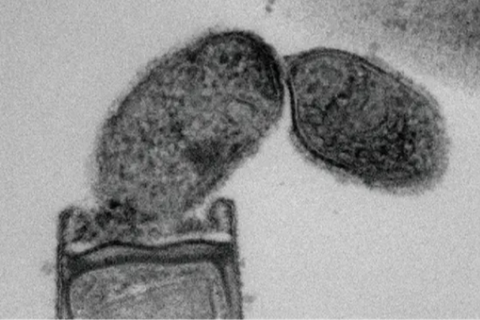National Institute of Advanced Industrial Science and Technology (AIST) researchers, in collaboration with Japan Agency for Marine-Earth Science and Technology (JAMSTEC), Hokkaido University and Tohoku University, have succeeded in cultivating an ultrasmall bacterial strain parasitizing archaea and classified the strain PMX.108T as new species and genus of Minisyncoccus archaeiphilus.

The team discovered, for the first time in the world, bacteria that parasitize the methanogenic archaea, which play a central role in anaerobic wastewater treatment systems. The ultrasmall bacterium inhibits the growth of the host methanogenic archaeon Methanospirillum hungatei.
This study, published in International Journal of Systematic and Evolutionary Microbiology, represents the first successful cultivation of ultrasmall bacteria that parasitize archaea, which evolutionarily diverged approximately 4 billion years ago and exhibit significant biological differences in cell membrane lipids, genetic information, and other biochemical characteristics. The bacterium was observed to have limited host range and to attach only host archaeon-specific sites.
READ MORE: ‘Picky eater’ parasitic archaea drive their hosts to change the menu
READ MORE: Efflux pumps conferring antibiotic resistance found in archaea for the first time
Furthermore, the researchers have proposed a new phylum Minisyncoccota formerly known as candidate phyla radiation (CPR). The phylogenetically classification and deposition of the CPR bacterium to a public culture collection will advance research on the CPR bacteria, and is expected to advance our understanding of the physiology and ecological role of the bacteria, which have remained a mystery until now.
The background
Candidate phyla radiation (CPR), a large bacterial phylogenetic group that includes various uncultivated lineages, are ubiquitous in natural and artificial environments, but their ecophysiology in ecosystems remains largely unknown due to the difficulty of cultivating them.
The CPR bacteria have been predicted to adopt a parasitic or predatory lifestyles on the host organisms because of their small cell and genome size and lack of biosynthetic pathways for their growth.
Although some CPR bacteria that demonstrate intra-domain interactions have been successfully cultured, there are no cases where cultured strains have been made publicly available through culture collections, which is hindering the progress in the research field.

No comments yet